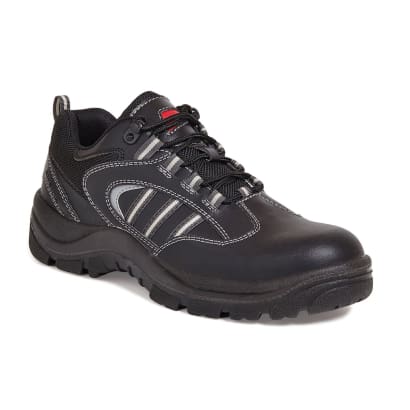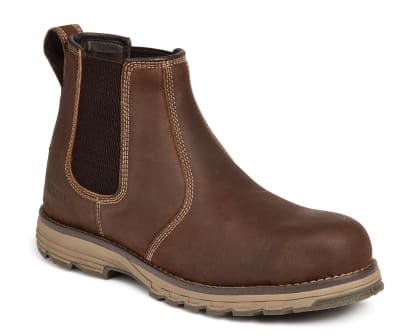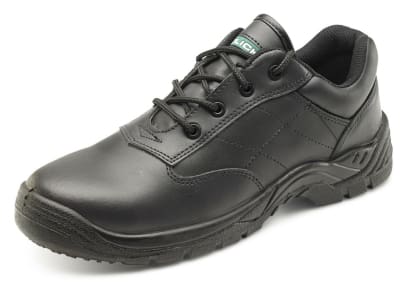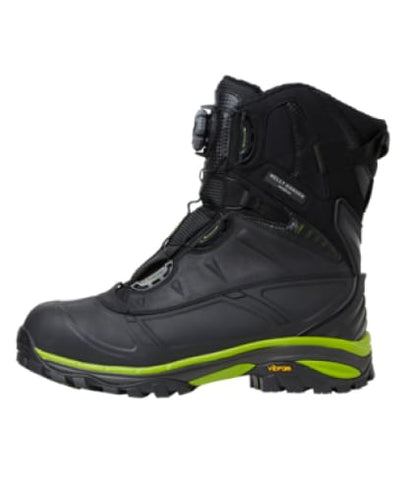Why Non-Steel Safety Footwear is Revolutionising Workplace Safety
- by Mike Johnson

Why Non-Steel Safety Footwear is Revolutionising Workplace Safety
Picture this: a construction worker narrowly avoids a debilitating foot injury, all thanks to their trusty pair of non-steel safety footwear. This scenario, once unthinkable, is becoming increasingly common as more workplaces embrace the advantages of composite and non-metallic safety footwear. Gone are the days when steel-toe boots were the only option, often compromising comfort and agility for protection.
In the ever-evolving landscape of workplace safety, non-steel safety footwear is emerging as a game-changer, offering a perfect blend of security, comfort, and versatility. This innovative solution addresses the limitations of traditional steel-toe footwear, paving the way for a safer, more productive workforce.
The Limitations of Traditional Steel-Toe Footwear
For decades, steel-toe boots have been the go-to choice for workers in industries like construction, manufacturing, and warehousing. While these rugged footwear options undoubtedly provided crucial protection against impact and compression hazards, they often came with a significant trade-off: discomfort and reduced mobility.
The sheer weight and bulk of steel-toe boots can lead to fatigue, ultimately hampering productivity and increasing the risk of accidents. Moreover, their metallic components pose limitations in environments with metal detectors or electrical hazards, restricting their versatility across various workplaces.
The Advantages of Non-Steel Safety Footwear
As the demand for safer, more comfortable, and versatile footwear solutions grew, manufacturers responded with innovative non-steel safety footwear options. These cutting-edge products leverage advanced composite materials, offering a range of benefits that traditional steel-toe footwear simply cannot match.
Lighter Weight and Increased Comfort
One of the most significant advantages of non-steel safety footwear is its lightweight design. By replacing steel components with composite materials like carbon fibre, kevlar, or non-metallic alloys, these shoes and boots offer the same level of protection without the added bulk and weight.
This reduction in weight translates into increased comfort and reduced fatigue, allowing workers to stay focused and productive throughout their shifts. No more achy feet or strained muscles from lugging around heavy steel-toe boots.
Enhanced Agility and Flexibility
In addition to being lighter, non-steel safety footwear often features more flexible and ergonomic designs. This increased agility and flexibility are crucial for workers who need to navigate tight spaces, climb ladders, or perform tasks requiring high mobility.
Whether a construction worker is manoeuvring through a cluttered job site or a warehouse employee is retrieving items from high shelves, non-steel safety footwear ensures that workers can move freely and safely without compromising their protection.
Wider Range of Applications
Traditional steel-toe footwear can pose challenges in certain environments, such as airports or facilities with metal detectors. Non-steel safety footwear, on the other hand, is free from metallic components, making it an ideal choice for workers in these settings.
Furthermore, electricians, utility workers, and others who operate in environments with electrical hazards can benefit from composite materials' nonconductive properties, reducing the risk of electrical shocks or burns.
Safety Features Still Intact
Despite their lightweight and versatile nature, non-steel safety footwear does not compromise on crucial safety features. These shoes and boots are designed to meet or exceed industry standards for impact protection, puncture resistance, and slip resistance.
Composite toe caps, midsole reinforcements, and advanced outsole technologies safeguard workers' feet from various hazards, ensuring their well-being on the job.
Material Innovations
The rise of non-steel safety footwear is fueled by continuous advancements in material science and manufacturing processes. Manufacturers are constantly exploring new composite materials and technologies to enhance the performance, durability, and comfort of these footwear solutions.
From lightweight yet incredibly strong carbon fibre composites to breathable and moisture-wicking linings, the future of non-steel safety footwear is bright, with even more innovative designs and features on the horizon.
Types of Non-Steel Safety Footwear for Different Needs
At Active Workwear, we understand that every workplace and job function has unique requirements for safety footwear. That's why we offer a diverse range of non-steel safety footwear options, each designed to cater to specific needs and preferences.
Airside Leather Water Resistant Composite Safety Trainer Shoe S3 SS705CM
Versatility is the name of the game with our Airside Leather Water Resistant Composite Safety Trainer Shoe. Whether you're working at an airport, construction site, or any other workplace, these shoes have got you covered. With their water-resistant design, you can kiss goodbye to wet, uncomfortable feet, even in damp conditions.
Available in an extended size range from 3 to 13, finding the perfect fit is a breeze. The padded collar and tongue ensure maximum comfort throughout your workday, while the composite toe cap and midsole provide superior protection without weighing you down.
The PU dual-density sole offers a winning combination of durability and cushioning, ensuring long-lasting wear and shock absorption. And let's not forget the chemical-resistant sole, making these shoes ideal for demanding work environments.
Safety Dealer Boot Apache Flyweight S3 Brown with Aluminium Toe and Composite Mid
If agility and ease of movement are paramount in your line of work, the Safety Dealer Boot Apache Flyweight S3 Brown is a perfect choice. Crafted with lightweight materials, these boots won't hold you back, allowing you to navigate your workday with ease.
But don't let their lightweight design fool you – these boots pack a powerful punch when it comes to protection. The aluminium toe cap and composite midsole work in tandem to safeguard your feet from impact and compression hazards.
The water-resistant design ensures your feet stay dry and comfortable, no matter the conditions. And with the lightweight Phylite/rubber outsole, you get the perfect blend of lightness and durability, ensuring a secure grip on various surfaces.
To top it off, these boots' anti-static properties help dissipate static electricity, adding an extra layer of safety to your workday.
Non-Metallic Composite Safety Shoe S1P Sizes 3 to 13 Click By Beeswift Cf52
Versatility meets protection in the Non-Metallic Composite Safety Shoe S1P Sizes 3 to 13 Click By Beeswift Cf52. This comprehensive safety solution is designed to keep you safe and comfortable across a wide range of applications.
The 200-joule composite toe cap and composite midsole protection work in tandem to shield your feet from impact and puncture hazards. The shock-absorber heel ensures that every step is cushioned, reducing fatigue and discomfort.
But that's not all – these shoes also feature slip-resistant and oil-resistant soles, ensuring a secure grip on even the most treacherous surfaces. The dual-density PU sole adds an extra layer of comfort and shock absorption, while the anti-static properties help dissipate static electricity for added safety.
Crafted with a durable leather upper, these shoes are built to withstand the rigours of demanding work environments, ensuring long-lasting performance and protection.
Helly Hansen Magni S3 Boa Fastener Winter Lined Composite Safety Boot – 78317
When the weather takes a turn for the worse, you need a safety boot that can handle the toughest conditions. Enter the Helly Hansen Magni S3 Boa Fastener Winter Lined Composite Safety Boot – 78317, a true powerhouse of protection and warmth.
Designed to support you in the most extreme environments, this boot features Helly Tech® and Primaloft® insulation, keeping your feet dry and toasty warm, even in temperatures as low as -50°C (-58°F). The Vibram® Fire and Ice rubber outsole provides unparalleled slip resistance, ensuring a secure grip on icy or wet surfaces.
But that's not all—your feet are further protected by a composite plate and toe cap, safeguarding against impact and compression hazards. For outstanding comfort over extended periods, this boot features a Dri-blaze lining and an Ortholite® sockliner, ensuring your feet stay fresh and supported throughout your workday.
To top it off, the BOA® Fit System allows for quick and easy on/off access, making this boot a true game-changer for those working in harsh winter conditions.
Choosing the Right Non-Steel Safety Footwear
With so many non-steel safety footwear options available, it can be challenging to determine which one is right for your specific needs. Here are a few key factors to consider when making your choice:
-
Work Environment: Evaluate the conditions and hazards present in your workplace. Are you exposed to wet or slippery surfaces? Do you need electrical hazard protection? Will you be working in extreme temperatures? Understanding your work environment is crucial in selecting the appropriate safety features and materials.
-
Required Safety Features: Different jobs demand different levels of protection. Consider the potential hazards you may face, such as impact, compression, puncture, or electrical risks, and choose a non-steel safety footwear option that meets or exceeds the relevant safety standards.
-
Comfort and Fit: Comfort should never be compromised when it comes to safety footwear. Look for options with cushioned insoles, breathable linings, and a snug yet flexible fit. Remember, ill-fitting footwear can lead to discomfort, fatigue, and even injuries.
- Desired Functionalities: Do you require water resistance, insulation, or slip resistance? Consider the specific functionalities you need based on your job tasks and work environment, and choose a non-steel safety footwear option that meets those requirements.
By carefully evaluating these factors, you can ensure that you select the perfect pair of non-steel safety footwear that not only keeps you safe but also allows you to perform at your best.
The Future of Non-Steel Safety Footwear
The non-steel safety footwear industry is constantly evolving, driven by ongoing research and development in material science and manufacturing processes. Manufacturers are continuously exploring new composite materials and technologies to enhance the performance, durability, and comfort of these footwear solutions.
One exciting development is the integration of advanced sensors and smart technologies into non-steel safety footwear. These innovations can provide real-time data on foot pressure distribution, temperature, and other biometric indicators, allowing for proactive injury prevention and improved ergonomics.
Additionally, there is a growing focus on sustainability and environmental responsibility in the footwear industry. Manufacturers are exploring the use of eco-friendly materials, such as recycled plastics or plant-based composites, to reduce the environmental impact of non-steel safety footwear production.
As the demand for safer, more comfortable, and versatile footwear solutions continues to grow, the non-steel safety footwear industry is poised to lead the way in innovation, setting new standards for workplace safety and worker well-being.
Conclusion
In the ever-evolving landscape of workplace safety, non-steel safety footwear has emerged as a game-changer, revolutionising the way we approach foot protection. By combining advanced composite materials with innovative design and cutting-edge technologies, these shoes and boots offer a perfect balance of security, comfort, and versatility.
At Active Workwear, we are proud to be at the forefront of this revolution, offering a diverse range of non-steel safety footwear options tailored to meet the unique needs of various industries and job functions. From lightweight and water-resistant trainers to winterised boots designed for extreme conditions, our collection is a testament to our commitment to worker safety and well-being.
Don't let traditional steel-toe footwear hold you back any longer. Embrace the future of workplace safety and explore our selection of non-steel safety footwear today. Visit our website or contact our knowledgeable staff to find the perfect pair that will keep you safe, comfortable, and productive on the job.
Remember, investing in quality non-steel safety footwear is an investment in your safety, your productivity, and your overall well-being. Take the first step towards a safer, more comfortable workday and join the revolution of non-steel safety footwear.
Frequently Asked Questions about Non-Steel Safety Footwear
1. What are the key benefits of non-steel safety footwear compared to traditional steel-toe boots?
Non-steel safety footwear offers several benefits, including being significantly lighter in weight, providing enhanced comfort, and offering better flexibility and mobility. These shoes are also non-conductive, making them ideal for environments with electrical hazards, and they don't set off metal detectors, making them suitable for security-sensitive areas.
2. How does non-steel safety footwear provide protection without steel components?
Non-steel safety footwear uses advanced composite materials such as carbon fibre, Kevlar, and non-metallic alloys to provide protection. These materials meet or exceed industry standards for impact and compression resistance, puncture protection, and slip resistance, ensuring the same level of safety as traditional steel-toe boots.
3. What types of non-steel safety footwear are available for different work environments?
There are various types of non-steel safety footwear designed for different work environments. These include water-resistant composite safety trainers, lightweight safety boots with aluminium toes and composite midsoles, winter-lined composite safety boots for extreme conditions, and non-metallic composite safety shoes for wide applications. Each type is tailored to specific needs like agility, protection, and comfort.
4. Are non-steel safety shoes suitable for electrical hazard environments?
Yes, non-steel safety shoes are suitable for electrical hazard environments because they are non-conductive. This means they do not conduct electricity, reducing the risk of electrical shocks or burns and making them an ideal choice for electricians, utility workers, and other professionals working around electrical hazards.
5. How does non-steel safety footwear enhance comfort and reduce fatigue?
Non-steel safety footwear enhances comfort and reduces fatigue through its lightweight design and ergonomic construction. The use of composite materials significantly reduces the overall weight of the footwear, while features like cushioned insoles, breathable linings, and flexible designs ensure a comfortable fit and greater freedom of movement, allowing workers to stay focused and productive throughout their shifts.
6. What should I consider when choosing non-steel safety footwear for my job?
When choosing non-steel safety footwear, consider the specific hazards present in your work environment, such as impact, compression, puncture, or electrical risks. Evaluate the typical weather conditions and the need for water resistance, insulation, or slip resistance. Additionally, it prioritises comfort and fit by looking for features like cushioned insoles and breathable linings. Finally, ensure the footwear meets or exceeds relevant safety standards for your industry.





